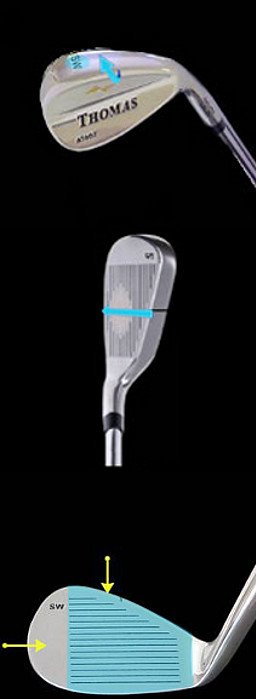When selecting a sand wedge, there are a number of different things a golfer should look for. Like any other club, the sand wedge should be tailored for the individual. A perfect sand wedge for you could be totally unsuitable in another golfer’s hands.

Just because a club is called a sand wedge by the manufacturer, don’t automatically assume they all have the same loft. Some manufacturers will set their sand wedge loft at 54 degrees with other brands setting the loft at 56 degrees.
This is important because some golfers will require more loft than others. In general terms, the golfer should be looking at increasing the amount of loft the sand wedge has. If given the option between a 54 degree and 56 degree sand wedge, most players would be better selecting the higher loft. This makes hitting high, floating shots from the sand much easier to accomplish.
Most specialized sand wedges will have the loft stamped on to the club head. However, sand wedges bought as part of a set may not. Always check with the store or manufacturer for the exact loft, it could save you shots.
The amount of bounce varies from sand wedge to sand wedge and it’s important to select the correct angle for your needs. The amount of bounce on a sand wedge could determine if your sand shots stay in the bunker or escape on to the green.
Bounce angle is created when the rear edge of a club’s sole is lower than the leading edge. This difference in height allows the rear edge to guide the club up through the sand and not allow the front edge to dig into the ground.
Players known as ‘diggers’ who take lots of sand or big divots when using the sand wedge would benefit more from having a wedge with a large bounce angle; about 12 to 14 degrees.
Players who take little sand or shallow divots, ‘skimmers’, would benefit more from a sand wedge with low bounce angle; about 6 to 8 degrees of bounce.
When selecting the amount of bounce angle, always consult with your professional to ensure you get the most from the club.
There are a plethora of materials and finishes used in the construction of sand wedges and finding the correct combination is important.
Some players will achieve a greater amount of spin with some materials than others so some experimentation is required. In general, most players will suit a heavier sand wedge when compared to their normal irons. This added weight can help players get through the sand more consistently lifting the ball on to the green. Soft forged steel generally gives the greatest amount of spin but the steel can have different finishes. Some wedges have a chrome plate finish which prevents the club head from rusting over time. Other wedges have a ‘gun metal’ finish which blackens the wedge to reduce glare. Some wedges have no finish at all which causes the wedge to rust which some players prefer.
Whichever wedge material and finish the golfer prefers they must ensure the wedge grooves remain clean and sharp. This will help ensure the maximum amount of spin is imparted on the ball.
Players selecting the perfect sand wedge first have to work out what loft, bounce, weight and finish suits their needs.
When looking for a perfect sand wedge, there are several important factors to consider. Here are some key features and characteristics to look for:
- Loft: The loft of a sand wedge is crucial for getting the ball out of the sand and onto the green. Generally, sand wedges have lofts between 54 and 58 degrees, which provides the necessary elevation to escape bunkers effectively.
- Bounce: Bounce refers to the angle between the leading edge and the lowest point of the club's sole. It helps prevent the club from digging too much into the sand, allowing for cleaner contact. A sand wedge with ample bounce (typically 10-14 degrees) is beneficial for different types of sand conditions and various swing techniques.
- Sole Grind: The sole grind refers to the shaping and contouring of the sole of the wedge. Different grinds cater to different playing styles and turf conditions. Common sole grinds include the standard sole, the versatile sole, and the wide sole. Choose a grind that suits your technique and the courses you frequently play.
- Forgiveness: Look for a sand wedge with a forgiving design. This means it should have a relatively large sweet spot, providing better results even on off-center hits. A forgiving wedge can help minimize the negative effects of mishits and provide more consistent performance.
- Feel: The feel of a sand wedge is subjective but crucial for many golfers. A good sand wedge should offer a balance between solid impact feedback and a soft, responsive feel. It's recommended to try out different wedges to determine which one provides the desired sensation during impact.
- Shaft: The shaft of a sand wedge should complement your swing tempo and overall preference. Some golfers prefer a softer shaft for increased feel, while others may prefer a stiffer shaft for more control. Consider factors like flex, weight, and material (steel or graphite) when choosing the right shaft for your sand wedge.
- Quality and Durability: Look for a sand wedge from a reputable brand known for producing high-quality golf equipment. Durability is also important since wedges endure considerable use in the bunkers and on the greens. Consider materials, manufacturing processes, and customer reviews to ensure the wedge is built to last.
- Personal Preference: Ultimately, personal preference plays a significant role in choosing the perfect sand wedge. Experiment with different brands, models, and features to find a wedge that feels comfortable and suits your playing style.
Remember, it's beneficial to test out different sand wedges before making a purchase, either by visiting a golf store or participating in demo days at your local golf course.





